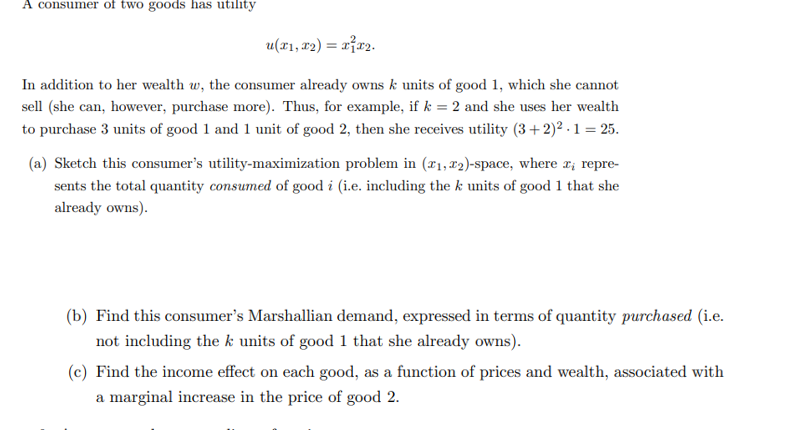goo u(x1, x2) = x²x2. In addition to her wealth w, the consumer already owns k units of good 1, which she cannot sell (she can, however, purchase more). Thus, for example, if k= 2 and she uses her wealth to purchase 3 units of good 1 and 1 unit of good 2, then she receives utility (3+2)2.1 = 25. (a) Sketch this consumer's utility-maximization problem in (₁,2)-space, where x, repre- sents the total quantity consumed of good i (i.e. including the k units of good 1 that she already owns). (b) Find this consumer's Marshallian demand, expressed in terms of quantity purchased (i.e. not including the k units of good 1 that she already owns). (c) Find the income effect on each good, as a function of prices and wealth, associated with a marginal increase in the price of good 2.
goo u(x1, x2) = x²x2. In addition to her wealth w, the consumer already owns k units of good 1, which she cannot sell (she can, however, purchase more). Thus, for example, if k= 2 and she uses her wealth to purchase 3 units of good 1 and 1 unit of good 2, then she receives utility (3+2)2.1 = 25. (a) Sketch this consumer's utility-maximization problem in (₁,2)-space, where x, repre- sents the total quantity consumed of good i (i.e. including the k units of good 1 that she already owns). (b) Find this consumer's Marshallian demand, expressed in terms of quantity purchased (i.e. not including the k units of good 1 that she already owns). (c) Find the income effect on each good, as a function of prices and wealth, associated with a marginal increase in the price of good 2.
Chapter4: Utility Maximization And Choice
Section: Chapter Questions
Problem 4.14P
Related questions
Question

Transcribed Image Text:A consumer of two goods has utility
u(x1, x2) = x²x₂.
In addition to her wealth w, the consumer already owns k units of good 1, which she cannot
sell (she can, however, purchase more). Thus, for example, if k = 2 and she uses her wealth
to purchase 3 units of good 1 and 1 unit of good 2, then she receives utility (3+2)²2.1 = 25.
(a) Sketch this consumer's utility-maximization problem in (₁,2)-space, where x¡ repre-
sents the total quantity consumed of good i (i.e. including the k units of good 1 that she
already owns).
(b) Find this consumer's Marshallian demand, expressed in terms of quantity purchased (i.e.
not including the k units of good 1 that she already owns).
(c) Find the income effect on each good, as a function of prices and wealth, associated with
a marginal increase in the price of good 2.
Expert Solution
This question has been solved!
Explore an expertly crafted, step-by-step solution for a thorough understanding of key concepts.
Step by step
Solved in 5 steps with 11 images

Knowledge Booster
Learn more about
Need a deep-dive on the concept behind this application? Look no further. Learn more about this topic, economics and related others by exploring similar questions and additional content below.Recommended textbooks for you


Managerial Economics: A Problem Solving Approach
Economics
ISBN:
9781337106665
Author:
Luke M. Froeb, Brian T. McCann, Michael R. Ward, Mike Shor
Publisher:
Cengage Learning


Managerial Economics: A Problem Solving Approach
Economics
ISBN:
9781337106665
Author:
Luke M. Froeb, Brian T. McCann, Michael R. Ward, Mike Shor
Publisher:
Cengage Learning